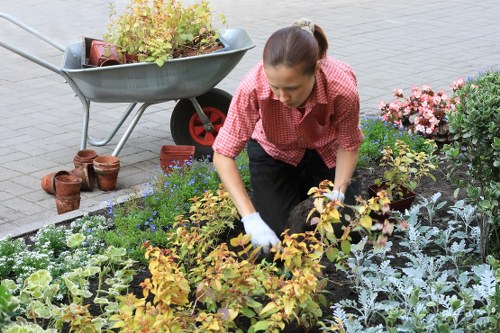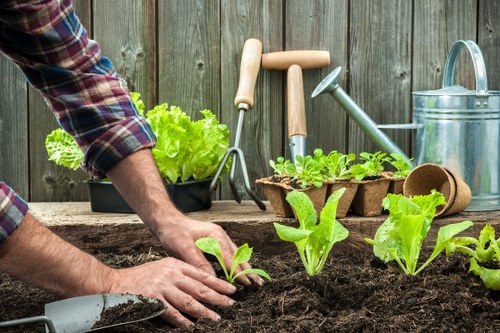Garden Maintenance Swiss Cottage: A Blend of Tradition and Modern Garden Care

Swiss cottage style garden maintenance is a unique combination of time-honored traditions and contemporary landscaping techniques. The beauty of a Swiss cottage garden lies in its balance between natural charm and carefully maintained landscaping. Homeowners who embrace this style enjoy lush greens, artfully arranged flower beds, and well-kept lawns that harmonize with the rustic architecture of the Swiss cottage.
Over the years, garden care for Swiss cottages has evolved. While traditional methods are still valued, modern techniques bring efficiency and sustainability to outdoor maintenance. Whether you are an experienced gardener or a beginner, understanding the nuances of garden maintenance in a Swiss cottage setting can dramatically enhance the beauty and functionality of your outdoor space.
Many homeowners find that the process of tending to a Swiss cottage garden is both therapeutic and rewarding. The act of trimming hedges, planting seasonal blooms, and ensuring that every corner of the garden is pristine connects you to nature. This article aims to provide practical tips, seasonal advice, and a discussion on how the Swiss cottage tradition influences modern landscaping.

Understanding the Essence of Swiss Cottage Garden Care
The art of garden maintenance is deeply intertwined with the history and culture of Swiss cottages. Swiss cottage gardens are celebrated for their simplicity, natural beauty, and meticulous design, which harmonizes with the surrounding landscape. Maintaining these gardens requires a blend of regular upkeep and seasonal adjustments to keep the environment healthy and vibrant.
Regular care involves water management, fertilization, and pest control. Each of these tasks must be executed with precision so as not to disturb the natural harmony of the garden. It is essential that every detail, from the smallest flower bed to the largest lawn area, receives the attention it needs.
Modern landscaping in Swiss cottages also values sustainability. Many gardeners are making efforts to use organic fertilizers, reduce pesticide use, and conserve water. These practices ensure that your garden remains not only beautiful but also environmentally responsible.

Practical Garden Maintenance Tips for Your Swiss Cottage
Seasonal care is crucial when it comes to preserving the pristine look of a Swiss cottage garden. Each season has its unique requirements: spring brings planting opportunities, summer demands frequent watering, fall is ideal for pruning, and winter duty often involves protection against harsh weather. By planning ahead, you can maintain a year-round appeal.
Begin with organizing a schedule for your routine tasks. For instance, divide your gardening duties into weekly, monthly, and seasonal tasks. Garden maintenance often includes mowing, hedge trimming, and mulching. Consider making a checklist to ensure that no detail is overlooked.
The effective use of garden tools is another essential aspect. Keep your tools in optimal condition with regular cleaning and maintenance. Replace or sharpen tools as needed, making sure that your garden work is efficient and injury-free. Additionally, investing in high-quality equipment can lead to better results and less time spent on upkeep.

Key Elements and Landscaping Techniques
There are several elements that make Swiss cottage garden maintenance special. The layout typically includes winding pathways, natural stone features, and neatly trimmed hedges, all harmoniously integrated with the surrounding landscape. This design choice reflects both elegance and practicality.
One effective technique is the use of companion planting. This method involves planting species that benefit each other. For example, interplanting flowers with shrubs can lead to pest reduction and improved soil health. These techniques not only enhance the aesthetic appeal but also contribute to the longevity of your garden.
Water features in Swiss cottage gardens add another layer of charm. Whether it's a small fountain or a reflective pond, these elements evoke a sense of calm. Ensure to maintain such features by cleaning regularly and checking for leaks. An orderly and well-maintained water feature can serve as the centerpiece of your garden, enhancing its overall atmosphere.

Seasonal Strategies for a Thriving Swiss Cottage Garden
Understanding the seasons is key to successful outdoor maintenance. In the spring, focus on replanting and refreshing flower beds. This season is perfect for removing winter debris and rejuvenating your garden with new growth. Early spring is an optimal period to add new plantings that can thrive in the upcoming warm months.
During the hot summer months, water management becomes critical. Ensure that your lawn and flower beds are not deprived of water. Using drip irrigation systems can help maintain consistent moisture levels while conserving water. Summer is also the best time to monitor for pests, which may become more active due to the heat.
In fall, it is time to prune dead branches and prepare your garden for the colder months. Autumn involves careful removal of fallen leaves and decaying matter to prevent the buildup of harmful fungi and mold. Fall work also includes strengthening the garden’s infrastructure to withstand freezing temperatures.
Winter Preparations for Your Cottage Garden
Winter is not a season for complete neglect. Instead, it is the time to safeguard the health of your Swiss cottage garden through proper winter care practices. Garden maintenance during winter is all about prevention and protection. Cover delicate plants with mulch or frost cloths to reduce damage from cold winds and snow.
Protect outdoor structures such as pathways, statues, and water features by ensuring they are free from ice formation. Regular, gentle maintenance can prevent irreversible damage that might be costly to repair in the spring. A well-planned winter strategy can provide a solid foundation for the blooming season ahead.
Even during the cold months, a quick inspection every few weeks can help you catch early signs of potential issues. Whether it’s a small leak in your irrigation system or signs of pests hibernating, preventive measures are key. This ongoing vigilance ensures minimal disruption when the warmer weather returns.
Modern Tools and Techniques in Garden Maintenance
Technology has significantly influenced the ways in which we manage and maintain our gardens. Smart irrigation systems can significantly reduce water usage by adjusting the watering schedule based on weather conditions and soil moisture. These systems are particularly beneficial for maintaining large lawn areas around Swiss cottages.
Robotic lawn mowers have also become a popular choice among modern gardeners. Not only do they save time, but they also maintain a level of consistency that is hard to achieve through manual labour alone. These devices allow homeowners more time to enjoy the beauty of their surroundings while trusting that their lawns are kept in top condition.
Software applications and digital calendars can assist you in keeping track of your gardening tasks. Using these digital aids helps in planning out the seasonal routines, ensuring each aspect of your garden maintenance receives due attention. Integrating modern technology with the classic Swiss cottage garden upkeep can result in a truly harmonious outdoor space.
Designing a Swiss Cottage Garden for Sustainability and Beauty
Design plays a central role in the success of any Swiss cottage garden. The design is marked by the interplay of natural elements and structured landscaping. Combining rustic charm with modern design principles can elevate the functionality of your garden, making it both beautiful and sustainable.
Consider the layout of your garden carefully. Incorporate meandering paths, circular flower beds, and strategically placed seating areas. Sustainable practices include the use of native plants that require minimal water and maintenance. By selecting the right species, you are also contributing to the local ecosystem's health, supporting native wildlife and pollinators.
Lighting is another crucial factor. Adequate lighting ensures that your garden is accessible and safe after sunset, while also adding a dramatic effect that highlights key features. Solar-powered lights are an eco-friendly choice that can enhance the beauty without significantly increasing your energy bills.
Fostering Community and Local Traditions
The charm of the Swiss cottage is not just in its architecture but also in the community it fosters. Neighborhoods with these cottages often take pride in their communal gardens. These communal spaces are a testament to shared values of sustainability, craftsmanship, and an appreciation for nature. Participating in community-driven garden maintenance can be deeply rewarding.
Local communities often host workshops and garden clubs that focus on sustainable landscaping methods and the preservation of traditional gardening skills. Such initiatives foster a sense of belonging and ensure that the knowledge surrounding Swiss cottage garden maintenance is passed down through generations. And even if you prefer working on your own garden, engaging with community experts can provide new insights and inspiration.
Many Swiss villages and towns have adopted regulations and policies to maintain the unique character of their environments, ensuring that new developments blend in with natural surroundings. As homeowners, adherence to these local traditions not only preserves the aesthetic appeal of your garden but also strengthens the cultural heritage of the region.
Local Relevance: Closest Areas to Swiss Cottage
The concept of Swiss cottage garden maintenance isn't limited to a single location; it resonates throughout the Swiss countryside. Numerous nearby areas are celebrated for their picturesque landscapes and rich heritage in garden care, showcasing unique adaptations of the Swiss cottage style. Below are some of the closest areas where you can experience this charm firsthand:
- Geneva - Known for its vibrant urban life blended with scenic lakeside gardens, Geneva offers a unique take on traditional Swiss cottage styling.
- Lausanne - Overlooking Lake Geneva, Lausanne has gardens that mix rustic elements with sleek modern designs.
- Bern - The capital city boasts cobblestone streets and lush, well-maintained gardens that reflect a deep-rooted Swiss tradition.
- Lucerne - With its stunning lake and mountainside views, Lucerne gardens often embrace natural rock features paired with carefully manicured lawns.
- Zermatt - This mountain village’s gardens are a beautiful juxtaposition of alpine flora and Swiss cottage rusticity.
- Interlaken - Nestled between two lakes, Interlaken gardens are designed to highlight the spectacular natural scenery while keeping traditional elements.
- Basel - With a mix of modernity and tradition, Basel’s community gardens feature innovative landscape designs alongside classic Swiss motifs.
- Lugano - Situated in the Italian-speaking part of Switzerland, Lugano gardens integrate Mediterranean influences with Swiss cottage traditions.
- St. Moritz - Known for its luxurious resorts, St. Moritz gardens are maintained with meticulous attention, mirroring the high standards of local architecture.
- Davos - This alpine town emphasizes sustainability in its outdoor spaces, combining energy-efficient methods with traditional garden care.
- Fribourg - Rich in medieval history, Fribourg gardens reflect the balance between old-world charm and modern outdoor living.
- Neuchâtel - Renowned for its lakeside elegance, Neuchâtel features gardens that are both serene and perfectly manicured, exemplifying the best of Swiss cottage garden maintenance.
These areas, each with its distinct flavor of Swiss culture and style, serve as inspiration for homeowners looking to recreate the Swiss cottage garden aesthetic in their own spaces. Visiting any of these towns not only exposes you to innovative garden techniques but also highlights how regional traditions can enhance modern outdoor maintenance practices.
Benefits of Embracing Garden Maintenance for Swiss Cottage Homes
Adopting regular garden maintenance for your Swiss cottage is a decision with long-lasting benefits. Firstly, it greatly increases your home's curb appeal. A tidy garden with flourishing plants is not only a pleasure to behold but also a strong enhancement for property value.
Regular upkeep results in reduced long-term maintenance costs. By addressing small issues early, such as trimming overgrown branches or correcting irrigation problems, you can prevent more significant issues from developing over time. In addition, a well-maintained garden reduces the need for expensive interventions during seasonal transitions.
Moreover, the process of caring for your garden can significantly reduce stress. Working outdoors in a tranquil environment, managing plant growth, and listening to the natural rhythms of your surroundings can improve overall well-being. This blend of physical activity and mental relaxation is invaluable in today's fast-paced world.
Tips for Getting Started with Your Garden Maintenance Routine
If you are new to the world of Swiss cottage garden maintenance, start with small, manageable tasks. Focus initially on the areas that are most visible, such as the front lawn or the main flower beds. Create a simple schedule outlining daily, weekly, and monthly tasks, and enhance your routine with seasonal planning.
Invest in good-quality tools and supplies. A reliable set of pruners, a sturdy hose, and organic fertilizers are a great starting point for your garden maintenance equipment. As you become more experienced, you may choose to invest in more advanced tools like smart irrigation controllers or robotic mowers.
Finally, educate yourself on the local climate and soil conditions. Every Swiss cottage garden may have unique requirements depending on its location. Consult local gardening centers, online forums, or even community garden clubs to gain insights that can be tailored to your garden's specific needs.
Final Thoughts on Swiss Cottage Garden Maintenance
Maintaining a garden in the Swiss cottage style is both an art and a science. It involves understanding the delicate balance between preserving historic charm and integrating modern practices. Whether you manage a sprawling outdoor expanse or a compact garden, the principles discussed are applicable and adaptable to your needs.
Every garden tells a story. In a Swiss cottage setting, the story is one of heritage, nature, and continuous care. By committing to regular maintenance, you not only preserve the beauty of your immediate environment but also carry forward a legacy that is deeply rooted in Swiss culture.
Remember, garden care is a journey rather than a destination. With ongoing adjustments and mindful attention to detail, your garden can thrive year after year. Embrace the traditions and innovations of Swiss cottage garden maintenance, and your outdoor space will be a source of joy, inspiration, and natural beauty for years to come.
Additional Insights and Resources on Garden Maintenance
For homeowners seeking to deepen their understanding of Swiss cottage garden maintenance, there are many resources available. Local workshops, gardening books, and online tutorials can offer a wealth of information tailored to both novices and seasoned professionals alike. Engaging with these materials not only improves your skills but also connects you with a broader community passionate about sustainable landscaping.
Embrace experimentation as you learn more about your garden’s particular needs. Small changes, whether in planting schedules, fertilizer types, or water usage, can lead to significant improvements over time. The journey of garden care is a continuous learning process that evolves with the seasons and the growth of your plants.
Finally, remember that each garden is unique, and it is essential to adapt general advice to your specific environment. The intrinsic beauty of a Swiss cottage garden comes from its natural imperfections combined with meticulous care. Celebrate the unique aspects of your garden, and let your maintenance routine reflect your personal connection to this timeless tradition.
Emphasizing the Impact of Community and Tradition
Community plays a significant role in the upkeep of Swiss cottage gardens. Sharing tips and experiences with neighbors, attending local garden fairs, or even participating in community maintenance projects can enhance your own practices. These shared experiences foster a network of support that not only benefits individual gardens but also preserves a cultural heritage that is cherished in many Swiss communities.
By embracing both tradition and modernity, your Swiss cottage garden will not only remain a testament to careful planning but also a living space that evolves beautifully with each passing year. The synergy between history and contemporary techniques is what makes garden maintenance in a Swiss cottage an art form worthy of pride and attention.
In conclusion, the journey of maintaining your Swiss cottage garden is an ongoing process that blends art, science, and heart. With a thoughtful approach, you can achieve a sanctuary that represents the best of Swiss heritage, where every plant and pathway holds a piece of tradition and a promise for the future.
Frequently Asked Questions
Q1: What is unique about Swiss cottage garden maintenance?
A1: Swiss cottage garden maintenance blends traditional techniques with modern practices, emphasizing sustainable practices, seasonal care, and a deep connection with nature. The design elements are unique, featuring rustic charm combined with meticulous garden care.
Q2: How often should I schedule garden maintenance tasks?
A2: It is ideal to have daily, weekly, and seasonal tasks. Daily tasks include simple checks and light cleaning, weekly tasks involve mowing and trimming, while seasonal tasks are more comprehensive like planting, pruning, and fertilizing.
Q3: Can modern technology be integrated into Swiss cottage garden care?
A3: Absolutely. From smart irrigation systems to robotic mowers and digital scheduling apps, technology has helped streamline garden maintenance while still preserving the traditional aesthetics of Swiss cottage style.
Q4: What are some sustainable practices recommended for maintaining these gardens?
A4: Sustainable practices include the use of organic fertilizers, water-conserving irrigation systems, choosing native plants, and minimizing chemical use. These practices not only protect the environment but also promote long-term garden health.
Q5: How can I adapt these techniques to suit my local climate?
A5: Understanding your local climate is essential. Consult local gardening experts, adjust watering schedules based on weather conditions, and select plants that are well-suited for your specific environment. Customizing these techniques will help ensure that your garden remains vibrant in any season.

